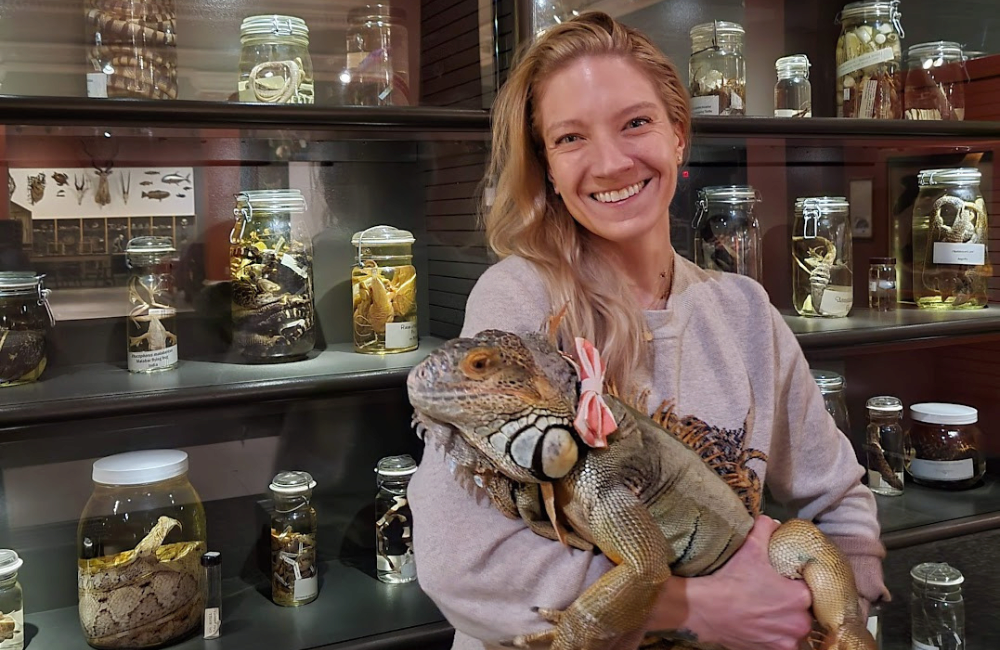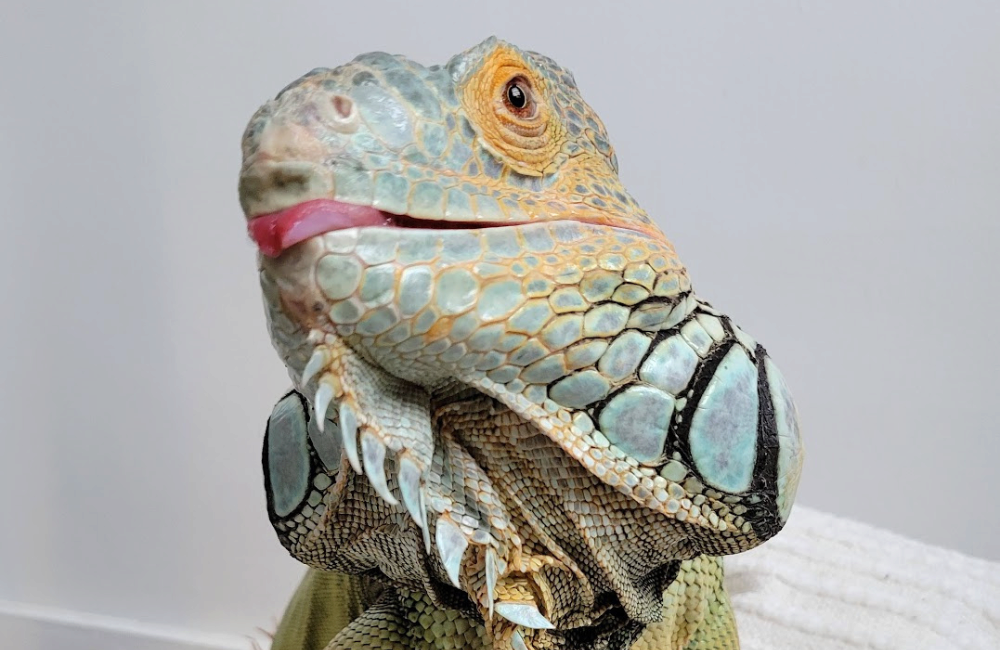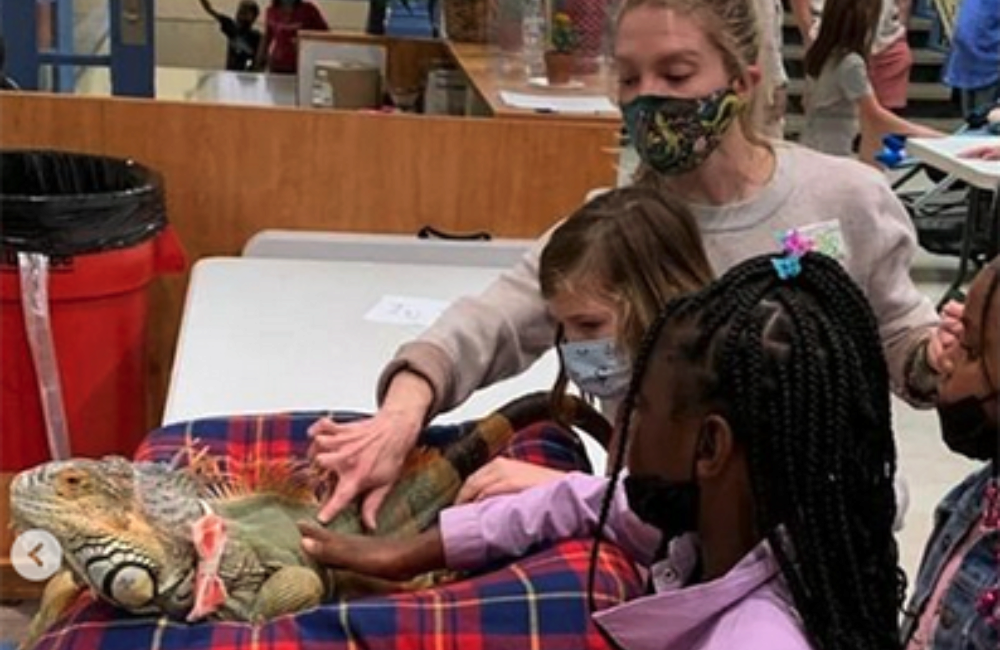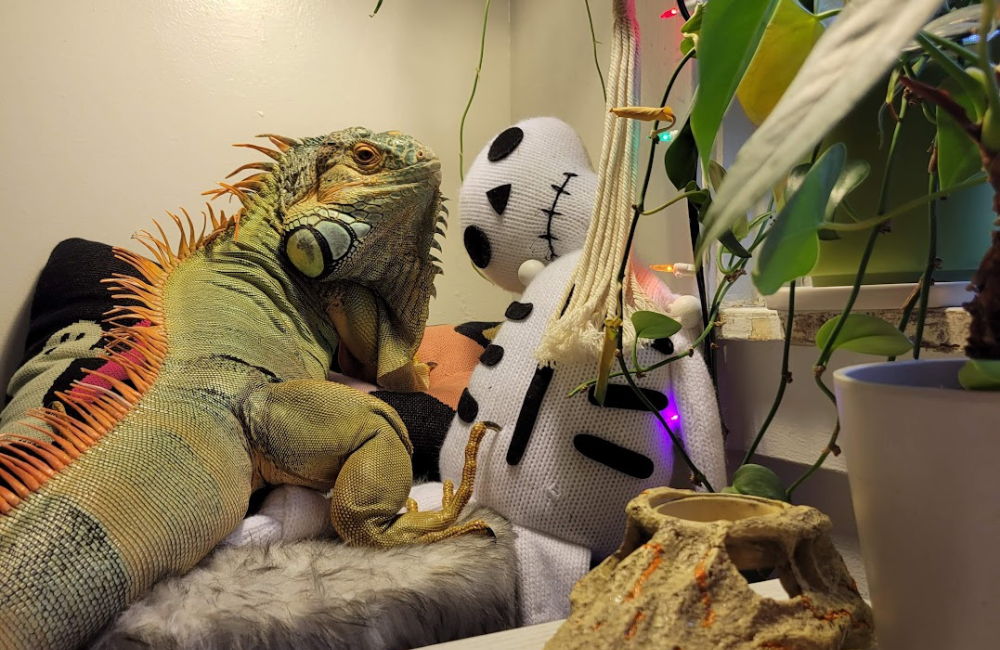Meet Blue — the Green Iguana — and His Human Mom, Lorren
Blue's a lucky boy. After being abandoned at a park by his previous owners in 2016, the iguana was rescued by his new human mom, master herpetologist Lorren Kezmoh of Pittsburgh, Pennsylvania.

Talk about the perfect match!
All About Her (Not So Little) Boy Blue
Blue is a 10-year-old green iguana that measures 5-foot-long and weighs just under 16 pounds. So, why is a green iguana named Blue? His moniker came from his handsome likeness to Jurassic World's velociraptor, Blue.
"When I adopted Blue, he was just a "little" 3-foot-long iguana that Pittsburgh Animal Care and Control officers suspected was intentionally abandoned, which occurs far more often than most folks realize or like to admit," Kezmoh explained. "In fact, Blue was just one of three iguanas that had made their way into the Animal Rescue League Shelter and Wildlife Center (ARL) that summer alone."
She says reptile pet owners often don't realize how large their pets can become, how long they live, and their very specific living requirements — from heating and lighting to nutrition and grooming (even scaly pets need a spa day!).

Kezmoh was a science fair kid growing up and now uses that passion not only to fuel her career as the manager of STEM Events & Competitions at the Carnegie Science Center but to love and care for Blue in the ways science dictates so he can thrive — and educate her community.
"The best way to communicate any information, whether it be the importance of proper animal husbandry or a reptile's role in the ecosystem, and make truly meaningful connections with people is through direct engagement and conversations," she shared.
A Purpose for Educating Reptile Parents
This love for all things usually deemed creepy or scary started as a child when Kezmoh would go fishing with her father and focused on catching frogs, tadpoles, and turtles, instead of baiting a hook.
Kezmoh used to work for the Animal Rescue League Shelter and Wildlife Center (ARL), which has since merged with the Western PA Humane Society (WPHS) and is currently known as the Humane Animal Rescue of Pittsburgh (HARP). There, she managed the organization's community outreach efforts. She refers to herself as a herptile lover (that's reptile + amphibian) who made sure the uncommon critters — like ball pythons, blue-tongued skinks, and White's tree frogs — also got their moment in the spotlight alongside pet cats and dogs.
"A big part of my job was physically showcasing adoptable animals as well as success stories at community events, educational programs, and fundraisers. And, until I had started at the rescue, very few people were comfortable handling reptiles and amphibians, so most of our adoptable exotics remained tucked quietly in staff-only spaces out of public view," she added.
When Blue became part of her family, Kezmoh started to share her story with potential adopters. Plus, she says he's quite the attention-grabber.
"It's very easy to strike up a conversation about reptiles when you have a giant lizard with you. I've spent the past six (going on seven) years taking Blue with me to events and programs, so at this point, it is second nature to him, and he handles it all extremely well," she explained.

When they get to the venue, Blue relaxes on a heated blanket, watches the crowd, enjoys gentle pets, and listens to his mom talk all about how to take the best care possible of a reptile pet. Blue approves, then relaxes and stretches his back legs behind him into what Kezmoh calls the "quintessential content lizard position."
#RepYourself: Finding a Love for Scaly Friends
During a rough patch in graduate school, Kezmoh was told to "grow a thicker skin" by one of her instructors. So she did by adopting a few reptile pets, including a chameleon named Dany which helped her focus on her studies and not the naysayers.
"To this day, I'm quite glad I took that advice literally because my reptiles are my daily physical reminder that I have overcome a lot and am just as resilient and tough as they are," Kezmoh reflected. "If it weren't for them, I would have never had this opportunity to encourage people to respect and appreciate the natural world and all the creatures that call it home."
In addition to Blue, Kezmoh currently shares her heart with eight other rescued reptiles and amphibians: a Russian tortoise, a veiled chameleon, a Northern Australian blue-tongued skink, a razor-backed musk turtle, a ball python, and three White's tree frogs.
"I've always been an avid animal lover and will never hesitate to assist an animal in need. That's one of the reasons I went to work in animal care and welfare. So, whenever a friend needed to rehome their animal or I simply bonded with one of the adoptable animals I had taken to an event, I more often than not took said animal home with me," she elaborated.
Kezmoh rarely turns away an animal in need if she has the space, capacity, and experience to give it proper care. She said when it came time to adopt her current "kiddos" (yes, the reptiles and amphibians), she didn't have to think about why she was bringing them into her home, but rather, when she could bring them home, where will they be most happy, and how could she make their lives better.
Bonding with Blue
In July 2023, Kozmoh will celebrate her seven-year adopt-aversary with Blue. During the first five years together, she focused specifically on relationship and trust-building with the new cold-blooded buddy. After all, iguanas can be a bit cantankerous and require regular handling and conditioning to become well-behaved.
"You can't adopt a reptile, even an adult or one that's been frequently handled, and expect it to be relaxed and friendly right from the start. It takes time, patience, and consistency. To keep Blue's relationship with people amicable, we spend a great deal of time with him every single day and follow a set routine to keep his life as stress-free as possible," Kezmoh shared.
The duo has several daily rituals they enjoy together. Kezmoh draws Blue a nice bath for his morning soak, then they share breakfast together and visit before it's time to check in on the other pets and get to work. In the evening, Blue is ready for more attention.
"It is extremely rewarding and special to have a 15.8-pound lizard decide to saunter down a flight of stairs, cross two rooms, and climb a couch just to snuggle up to you. Granted, he is likely doing this to assert his dominance over us (the family) and the household, but we don't mind sharing all of our warmth or ultraviolet light with him," she joked.
Meeting Blue's Health Needs
Due to his large size, Blue has his own room in Kezmoh's home, complete with ultraviolet and basking lights. Kezmoh explained it's essential for all reptile and amphibian parents to have an ultraviolet light meter of some kind to test the efficacy of their animal's lighting because, over time, the UV output diminishes — even when it looks bright to you.
"For reptiles and amphibians to fully metabolize calcium and produce vitamin D3, they need access to 10 to 12 hours of consistent ultraviolet light exposure within the animal's respective natural basking Ultraviolet Light Index (UVI)," she shared.

If the light is too strong, the pet can get the equivalent of a sunburn. Ouch! So, when it comes to reptile keeping, proper lighting is a must-have.
Kezmoh has been experimenting with the Zilla Rapid Sense™ Decor to check on Blue's UV lighting. She says the decor is helpful because it provides a constant idea of how your ultraviolet light is performing.
"The decor also allows you to get an approximate idea of your bulb's output without aggravating easily stressed animals by sticking a meter into their enclosure," she added. She also enjoys that the crocodilian skull design serves as cool decor and doubles as a food dish (the larger size), shelter, and climbing structure for smaller reptiles.
The sensor comes in both the crocodile skull or a poplar log option to best coordinate with your herp's habitat. When the indicator on the Rapid Sense Decor is exposed to light, it changes color, making it easy to know when to change the bulb. Both designs also include accents that fluoresce under a black light to add a pop of color to your reptile's home.
Kezmoh says using a digital radiometer is also a good idea to get exact UVI measurements down to the decimal point. Think of a color change on the Rapid Sense Decor as an initial indicator (much like the ping of a reminder on your cellphone) that it's time to use the radiometer for a more precise measurement. Kezmoh says she loves that the decor takes the guesswork out of lighting management, especially for novice reptile parents.
"You'll definitely get quite a bit of bang for your buck," she added.
Kezmoh's come a long way to help herps since spending time lakeside fishing with her father and bonding with her first pet, Murtle the box turtle, a rescue from a construction site. Learn more about Kezmoh's outreach, education, and adventures with Blue on Instagram at @bluethegreeniguana.
